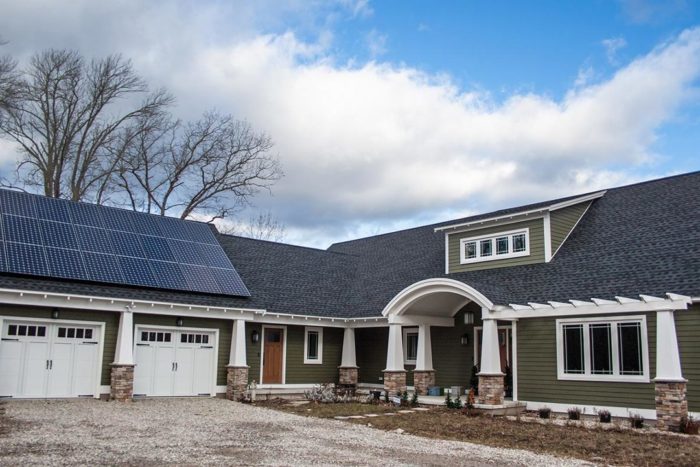
Image Credit: Lehto Design/Build
Image Credit: Lehto Design/Build Wolfworks was the co-winner of the CT Zero Energy Challenge with this design in Farmington, Connecticut. The firm also won the top prize the previous year.
Image Credit: Wolfworks The kitchen of the Killingly house. With a conventional truss roof above, the timber trusses don't have to provide structural support. The ceiling is insulated with dense-packed cellulose.
Image Credit: Lehto Design/Build An open design makes heating and cooling easier. The 2,619-square-foot house submitted by Nick Lehto is conditioned with a Mitsubishi ductless minisplit heat pump.
Image Credit: Lehto Design/Build The Farmington house is heated and cooled with a ducted minisplit concealed in the ceiling. The system has a single supply line for the main level and a single supply for the lower level.
Image Credit: Wolfworks Getting a look at the details: A mid-construction tour of the Farmington house built by Wolfworks offered a close look at the double stud-walls, insulated with a combination of dense-packed cellulose and polyisocyanurate insulation.
Image Credit: Wolfworks
Two Connecticut builders can claim top honors in the most recent CT Zero Energy Challenge, a design competition that promotes high-efficiency houses with a low environmental impact.
Nick Lehto and Jamie Wolf are both being recognized as Overall Winner, and each will apparently receive a $10,000 check. Scores were based on judging in four categories: lowest overall HERS index, lowest HERS index without renewable-energy add-ons, lowest cost per square foot, and lowest projected annual net operating costs.
Lehto Design/Build’s entry was a 2,619-square-foot single-story home in Killingly, Connecticut.
Wolfworks won for a 2,932-sq/ ft. house in Farmington, Connecticut. It’s the second such award for Jamie Wolf, the design/build firm’s principal. A Passivhaus-certified home his firm built in Harwinton was the 2012 contest winner.
Among eligibility requirements: single-family and multifamily projects must have a HERS index of 45 or less without renewable energy systems and be new construction or a complete gut rehab. The contest is sponsored by Energize Connecticut, an initiative that helps homeowners, renters, and businesses use energy more efficiently.
Green Building Advisor was unable to reach the contest administrator for scoring details, but Lehto and Wolf thought the results would be formally announced a little later in the year.
A family farm is the setting for Lehto project
Lehto’s clients were a couple who live on a farm that has been in the husband’s family for a century. They occupied an old farmhouse on the property, the same house where the husband had been born. But the woman was interested in moving into something more up to date — just not too contemporary.
“Her initial thought was that an energy-efficient house would have to be some type of modern cube,” Lehto said, “which I think, sadly, a lot of people have that stereotype. When she saw that the homes we did basically look like normal homes she was very interested in going forward. The more she involved she got, the more she learned, the more excited she got about the whole thing.”
They brought Lehto plans for a home with some Arts & Crafts detailing, which they had purchased at a web site called The Red Cottage. He modified the floor plans, reoriented the garage and applied energy-efficient construction practices. The house has two bedrooms and two bathrooms.
Lehto came to the building trades early. His father and uncle are both builders, as are two of his cousins. But it was in 2008, on a trip to Finland, that Lehto was first introduced to some unfamiliar building components. “That was the first time I’d ever encountered an air-source heat pump,” he said. “Growing up in New England, I didn’t know an air-source heat pump even existed. The fact that they were using them in that climate, I was pretty impressed. And basically they don’t have any windows that aren’t triple-paned. That really opened my eyes as to what was available.”
He returned to the U.S. a convert.
Straightforward construction, tight building envelope
The double 2×4 stud exterior walls are 12 inches thick and filled with dense-packed cellulose to R-45 (Lehto has his own insulation blower because he’s had trouble finding an insulation subcontractor in his area that does cellulose). The trussed roof is insulated to R-70 with 20 inches of blown-in cellulose.
He used nothing more exotic than plywood sheathing and 3M 8067 flashing tape for the air barrier in the exterior walls. Gypsum drywall is the ceiling air barrier. Where partition walls meet the ceiling, Lehto sprayed polyurethane foam from the top to seal potential leaks.
A blower-door test measured air leakage at 0.38 air changes per hour at a pressure difference of 50 pascals (ach50).
Other features include:
- A foundation made of insulated concrete forms (R-22); there are also 4 inches of extruded polystyrene insulation under the slab (R-20).
- A State heat-pump water heater for domestic hot water, and a three-head Mitsubishi ductless minisplit air-source heat pump for space heating and cooling.
- Triple-glazed Mathews Brothers windows with a U-factor of 0.18 and a solar heat gain coefficient of 0.26.
- A roof-mounted photovoltaic array rated at 8.5 kilowatts.
Wolfwork’s design also uses double stud walls
Jamie Wolf’s clients wanted a smaller retirement home, something he sees a lot these days. Wolf combined net-zero energy performance with Sarah Susanka’s Not-So-Big-House thinking to produce the 2,932-square-foot three-bedroom home in Farmington.
One key to high performance is a “sandwich wall” that combines dense-packed cellulose and rigid polyisocyanurate foam board. The structural outer wall is built with 2x6s, the inner wall with 2x4s. The air barrier is Huber’s ZIP system sheathing, taped at the seams.
“We build that first wall, and our air barrier is complete,” Wolf explained. “When we build that first wall, we do a fog test and a blower door test then so if there’s anything that needs to be fixed we can see it and get at it and we can fix it.”
Next, Wolf added dense-packed cellulose to the outer wall, installed 3 inches of rigid foam, and then built the inner 2×4 wall and dense-packed that. Above-grade walls have an R-value of 50.
“It’s worked really well for us,” he said, “because it’s easy for everyone to understand how to build it. We just tell the framers the interior wall is just another partition wall and it’s built at the same time the partition walls are built.”
The outer framed wall is built 24 inches on center; the inner wall at 16 inches o.c., which Wolf says keeps trim carpenters happier. The two walls are tied together with plywood window bucks sealed with Siga tape.
The air barrier at the ceiling level is a layer of plywood applied to the bottom chord of the roof trusses. That may be a little unconventional, but Wolf says it helped remind subs on the job how important it was to keep the air barrier intact.
Foundation walls are insulated on the inside with 2 inches of polyiso rigid foam, plus a 2×6 stud wall filled with dense-packed cellulose for a total R-value of about 34. There are 6 inches of expanded polystyrene (EPS) under the slab, rated at R-24.
Airtightness was measured at 0.49 ach50.
Heating and cooling with a ducted minisplit
Wolf chose a single-ceiling-head Fujitsu ducted minisplit for heating and cooling. The system has a single supply for the main level of the house, and a second supply for the lower level. There’s a single, short return duct on the main floor.
There are no separate supplies for the bedrooms and other separated spaces. In winter, if you close a door to the bedroom at night, the temperature in that room will slowly sink. Wolf’s clients were satisfied the system would work for them, but he points out that it’s not the kind of heating and cooling system for everyone.
“To do this, two things are important,” Wolf said. “One is that you have this level of performance, a Passivhaus-level building envelope so that the rate of heat loss is really slow. What happens is these spaces stabilize at an even temperature so it doesn’t take very much to bring them back up to temperature.”
Also, anyone living in a house with a similar system has to be OK with leaving doors to bedrooms and other spaces open most of the time. “This is not a home where, let’s say, your young adult lives with the door closed all the time,” Wolf said.
Other features of the house:
- A Zehnder heat-recovery ventilator, which Wolf describes as “pricey and fabulous, beautifully engineered and easy to install.”
- A heat-pump water heater.
- Triple-glazed Schüco windows.
- A 10-kW photovoltaic array.
Wolf is getting very good performance out of relatively straightforward building techniques and ordinary materials. “There are two parts to this,” he said. “There’s designing it and building it. And the whole point is that in the design phase you have to have a pretty sophisticated understanding of all the principles that make these houses work.
“But if you design those in,” he added, “you kind of bake them into the design, and think practically as a builder, too, it’s very doable. It’s not hard to show people how to do it even if they haven’t done it before.”
Weekly Newsletter
Get building science and energy efficiency advice, plus special offers, in your inbox.





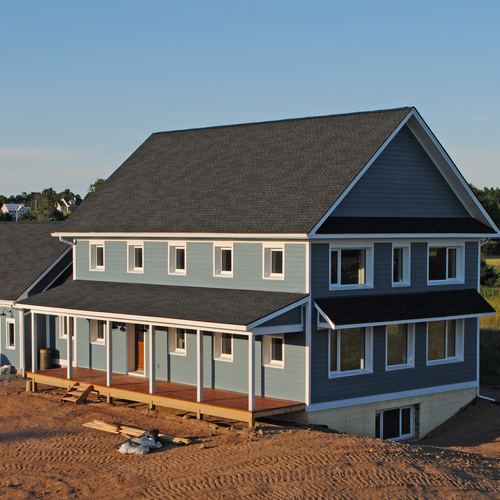
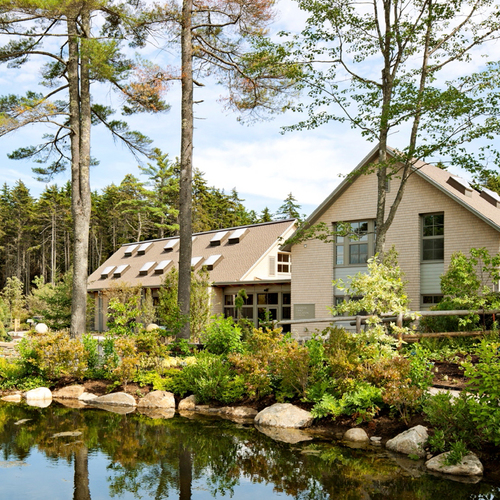
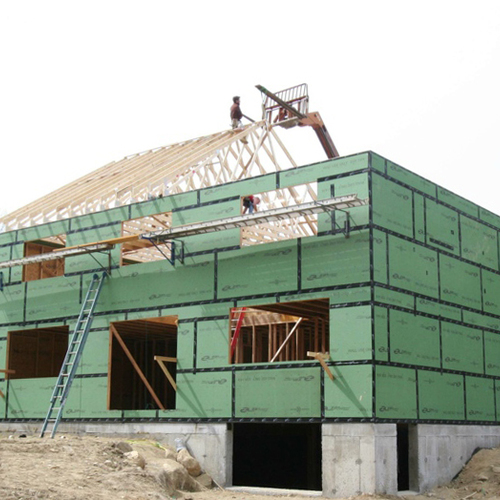
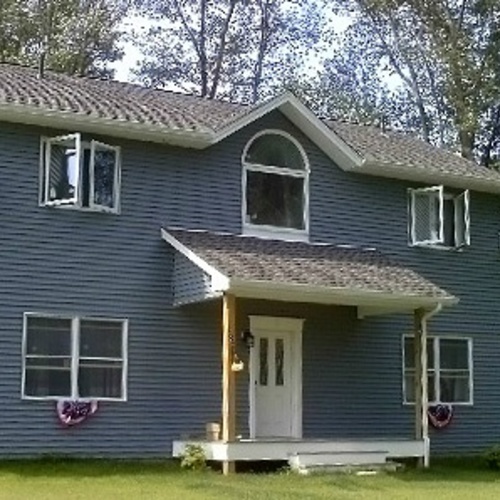






7 Comments
Privacy Issues anyone
I'm the only person that gets denials on single head minisplits because privacy issues? Does having the lowest HVAC system is more important than privacy "comfort"? Do we force a couple or teenagers to live with their doors open always? (maybe not for the first buyer, but what about the next)
Aesthetics
I'm surprised that design isn't one of the categories of judgement. Wolfworks puts together efficient houses, but I wasn't impressed with the floor plan / overall design of the house (I saw it after the drywall was up). I haven't seen the other winner, so I can't comment to compare. Nor do I know if the home owner, who was involved with construction, had a lot of say in the layout.
I understand it's a competition for energy efficiency sponsored by utility companies, but still...
Design Matters
Dwight is right. Aesthetics matter.
But, after admitting that he really doesn't know much about the project except what he claims to have seen, I have to take exception to his judgement and conclusions.
This is a project being celebrated for its ability to produce more energy than it uses on an annual basis. So in that sense energy matters.
This is a project designed in response to a site, a client, and a set of aspirations aligned with an ethic, best expressed by two great thinkers:
Marc Rosenbaum: "Favor envelope over machinery"
Sarah Susanka: "Favor quality over quantity of space"
So structure and function matter.
The project fulfilled a set of very practical objectives for thoughtful and engaged clients with the kind of values and good sense we all wish for in the people we serve. The resulting floor plan works beautifully and great care was taken to assure it was only as big as it needed to be, and no bigger - all the space is in service to the life of the home. And they love it!
To suggest that this project is a design failure is an affront. It is a design success. My practice of design and its integration with the process of construction is based on the premise that above all, design matters.
Design is not making something pretty. Nor is it creating a machine that runs smoothly or a project that can be built successfully and completed profitably. It is the ability to integrate and succeed at doing all these things as thoughtfully and comprehensively as possible in service to a well defined project with clear goals and appropriate resources.
There is no award for that. There is only the reward of getting some quotient of all those goals as right as we are able on a given project, observing where we fell short, and trying to apply those insights to doing better the next time. These are the same reasons why I am a NESEA member and a GBA subscriber.
I'm happy to hear about the ways in which folks observe we fell short, but be specific. I sent Scott Gibson the plan set but it is not posted. Short of looking at that, its not that helpful to hear that someone without much understanding of the project was not impressed with our effort.
What we choose to build is a significant responsibility. Our choices are embedded in time. This building will last a long time. Locking in an energy operating budget of zero was one of those choices. So was the floor plan we developed and the durable finishes we chose. So was the craft we applied to the architectural details you can see in the images that are posted.
We're proud of this project for all these reasons, and certainly pleased about the recognition for its energy performance. It is the direct result of giving our full attention to the awareness that DESIGN MATTERS.
To read our blog post about this project and see more images of this home visit homesthatfit.com/blog. To see our projects featured in Sarah Susanka's books visit homesthatfit.com and go to our portfolio.
Absolutely Design Matters
I agree with Jamie Wolf, design absolutely matters. As an architect that routinely designs very low energy homes - design does matter. I always joke we don't want them to look like tool sheds from the 70's. As an architect, I also realize that every project has an associated set of parameters, a client wish list, a budget, and in this case an energy conscious, which I commend. I personally find it insulting to think that Mr Wolf and his clients had disregarded "design". Not every project I do has an endless aesthetic budget to team up with an above average performance budget. I regularly find this a challenge myself. To suggest the client may have not been involved is silliness. Of course they were. I know of know client out there writing checks to someone else's design ideas without knowledge. If you know of one please let me know, I have some ocean front property they might be interested in.
As for the design, I find it to be a modest exterior, but not worthy of ANY insult, and a job very well done, GOOD JOB JAMIE!!! The part of this project I find the most compelling is that this is a home that we can bring to mainstream America, and ACTUALLY solve some problems. And I have seen the drawings and pictures of the interior, and find the project commendable.
My apologies
Jamie, my comments were obviously taken as an insult to a lot of hard work that went into the house. I didn't mean to imply that the house was a "design failure." You're right Steve, it isn't worthy of insult. I apologize - that wasn't my intention. True, the modest aesthetics didn't impress me, but that doesn't mean I don't appreciate designing and building a passive house that resulted in an extremely pleased client. That's a design success.
Personally I like the exterior of the other winner, but like I said, I haven't really seen either house nor the circumstances of the client's wishes. I was commenting on the lack of a category for aesthetics - being pretty - in the competition. Again, I apologize.
Back Against the Wall
I believe we as designers and architects are in exciting times but difficult times. My experience as a designer of these low energy homes is that because of their performance requirements like 18" walls, we have an abundance of design options available to us. The problem I find is that because of the performance consciousness we design to with our clients, our backs are against the wall to develop higher degrees of aesthetics. Part of the problem I see is that clients comparing these homes costs to that of code built homes. Getting a client over that hurdle is a huge success I find. One of the issues we as a unified design community need to develop in our building culture is the "idea" that these low energy homes is where we need to be thinking, and financially measuring from a base line nearer these homes rather than a code built home. Equally difficult is having the client I know can easily afford these type of enhancements but chooses to build it conventionally knowing the cost of energy is no problem for them. In both cases we have our work cut out for us. Any examples where we can prove that not only these homes work, but far more importantly that "Some client believes in this idea" will only help our building culture to prosper in this realm.
I've built both fancy and
I've built both fancy and simple houses and I know the greater challange is in designing a simple yet beautiful house and I commend Jamie for doing an excellent job of just that.
Log in or create an account to post a comment.
Sign up Log in